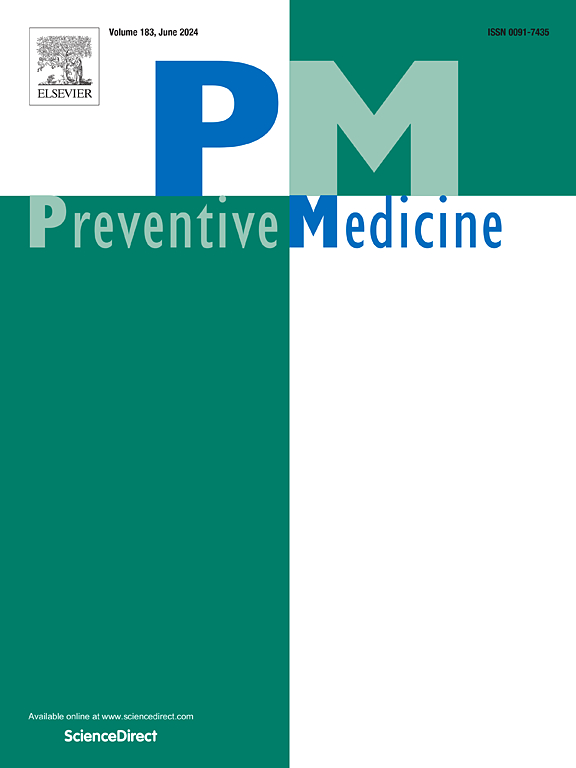Determinants of smoke-free homes adoption among Spanish adults who smoke: A prospective cohort study from the 2016–2021 International Tobacco Control (ITC) EUREST-PLUS Spain Surveys
IF 3.2
2区 医学
Q1 MEDICINE, GENERAL & INTERNAL
引用次数: 0
Abstract
Objective
To assess the prevalence and associated factors of smoke-free homes (SFHs) among Spanish adults who smoke across three cohort waves, and to identify determinants of SFH adoption during follow-up (2016–2021).
Methods
The International Tobacco Control EUREST-PLUS Spain Survey is a nationally representative cohort of ∼1000 adults (≥18 years) who smoke surveyed in 2016, 2018, and 2021. First, we conducted repeated cross-sectional analysis to estimate the prevalence of SFHs at each wave. Second, we estimated incidence and risk ratios (RR) with 95 % confidence intervals (CI) for SFH adoption during the follow-up using adjusted generalised linear models. Independent variables included sociodemographics, smoking characteristics, and beliefs about second-hand smoke harms.
Results
SFH prevalence was 13.1 % in 2016, 19.0 % in 2018, and 31.5 % in 2021 (p trend <0.001). Quitting smoking (RR = 2.66; 95 % CI: 2.10, 3.36), remaining in any stage other than precontemplation (RR = 1.76; 1.13, 2.73) and progressing beyond precontemplation stage (RR = 2.59; 1.99, 3.37) were determinants of SFH adoption. Maintaining moderate or high nicotine dependence (RR = 0.46; 0.30, 0.69) was inversely associated with SFH adoption.
Conclusions
SFH prevalence among Spanish adults who smoke increased in 2016–2021. Initiatives promoting SFHs should encourage progression through the stages of change towards cessation and provide tailored support for individuals with high nicotine dependence.
西班牙吸烟成年人采用无烟家庭的决定因素:2016-2021年国际烟草控制(ITC) EUREST-PLUS西班牙调查的前瞻性队列研究。
目的:评估三个队列波中吸烟的西班牙成年人中无烟家庭(SFHs)的患病率及其相关因素,并在随访(2016-2021)期间确定无烟家庭采用的决定因素。方法:国际烟草控制EUREST-PLUS西班牙调查是在2016年、2018年和2021年对吸烟的约1000名成年人(≥18 岁)进行的全国代表性队列调查。首先,我们进行了反复的横断面分析,以估计每一波SFHs的患病率。其次,我们使用调整后的广义线性模型估计随访期间采用SFH的发生率和风险比(RR)为95 %置信区间(CI)。独立变量包括社会人口统计学、吸烟特征和对二手烟危害的看法。结果:2016年SFH患病率为13.1 %,2018年为19.0 %,2021年为31.5 % (p趋势)。结论:2016-2021年西班牙成年吸烟者中SFH患病率上升。促进SFHs的举措应鼓励戒烟阶段的进展,并为高度尼古丁依赖的个人提供量身定制的支持。
本文章由计算机程序翻译,如有差异,请以英文原文为准。
求助全文
约1分钟内获得全文
求助全文
来源期刊

Preventive medicine
医学-公共卫生、环境卫生与职业卫生
CiteScore
7.70
自引率
3.90%
发文量
0
审稿时长
42 days
期刊介绍:
Founded in 1972 by Ernst Wynder, Preventive Medicine is an international scholarly journal that provides prompt publication of original articles on the science and practice of disease prevention, health promotion, and public health policymaking. Preventive Medicine aims to reward innovation. It will favor insightful observational studies, thoughtful explorations of health data, unsuspected new angles for existing hypotheses, robust randomized controlled trials, and impartial systematic reviews. Preventive Medicine''s ultimate goal is to publish research that will have an impact on the work of practitioners of disease prevention and health promotion, as well as of related disciplines.
 求助内容:
求助内容: 应助结果提醒方式:
应助结果提醒方式:


